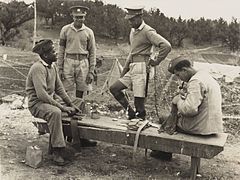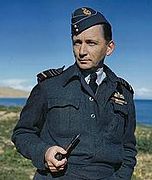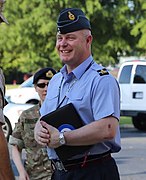Forage cap
Forage capis the designation given to various types of military undress, fatigue or working headwear. These vary widely in form, according to country or period. The coloured peaked cap worn by the modernBritish Armyfor parade and other dress occasions is still officially designated as a forage cap.[1]
History[edit]
In the 18th century, forage caps were small cloth caps worn by Britishcavalrymenwhen undertaking work duties such as foraging for food for their horses. The term was later applied to undress caps worn by men of all branches and regiments as a substitute for the full dress headdress.[2]
Usage[edit]
French Army[edit]
During theFrench Revolutionary Wars,French soldiers made their own forage caps from the cloth of old coats.[3]Known as thebonnet de police,these caps resembled anightcapand were also worn bySanta Anna's army during theMexican War.From the 1840s until World War I, French line infantry wore the blue and redkepi,but in 1915, thebonnet de policewas reintroduced as a horizon bluegarrison cap.[4]
Worn in a khaki version until 1940, thebonnet de policeretained the high pointed crown of 1915–1918.[5]During World War II French forces wore a wide variety of headdresses according to supplies available. In 1945 however thebonnet de policewas reintroduced for most units but with a lower crown and in the historic colours that had formerly distinguished the kepis of each branch.[6]By the 1940s, the beret was also widely worn by paratroop and mountain units.
German Army[edit]
The German army was the first to use thepeaked cap,in the final years of theNapoleonic Wars.[citation needed]When thePickelhaubewas introduced in the 1840s, the Germans adopted a new, peakless forage cap, resembling thesailor cap[citation needed].Prior to 1914 these caps were worn in a wide variety of colours according to regiment or branch, withPrussian bluethe most common.[7] However, in 1917 these were replaced with aslate greyversion, with a dark green cap band. After World War I, the GermanWehrmachtused a variant of thegarrison capcalled the Feldmütze, before adopting the Austrian-styleski capof theGebirgsjäger.
-
German peakless forage cap of WWI, based on the type worn by sailors.
-
Three German Second World War soldiers, two wearing forage caps
-
Bundesgrenzschutz(Federal Border Guard)Feldmützecap, in use until 1976
Greek Army[edit]
In Greece forage caps were adopted during the period of the First World War, when most of the weapons and supplies were of French origin. From then until World War II, various changes were made while keeping key features. The Greek Army Regulations of 1938 introduced an improvement concerning the folding part of the cap which protects the ears.
-
Three Greek Second World War soldiers, wearing forage caps mod.1938.
-
Greek Forage Cap mod.1938
Austro-Hungarian Army, Austrian Army, and Royal Hungarian Army[edit]
TheAustro-Hungarian Armyadopted a cap in the 19th century fitted with a peak and cloth chinstraps (orflaps). The chinstraps could be buttoned over the forehead, either securing the folded-up peak or leaving it loose, or could be buttoned under the chin, extending the rear of the cap downwards to protect the ears from the elements. This cap continues in military (Österreichisches Bundesheer), border guard (Österreichs Garde),[8]and police use with theRepublic of Austria,although the camouflaged version worn today retains only the peak, not the chinstraps, of its predecessor).[9][10]After the break-up of theAustro-Hungarian Empire,theRoyal Hungarian Armyhad also continued to issue this type of cap. Variations on this cap were adopted by other armies.
-
Austro-Hungarian soldiers during the First World War
-
Austriantroops training withM1 Garand riflesduring the 1950s
-
Hungarian soldiers in the Carpathians in 1944 (one wearing a helmet and the rest wearing forage caps)
-
Hungarian soldier, 1940
-
Uniform, military, commercial vehicle, Hungarian brand, tableau, Rába-brand Fortepan 22344
United Kingdom[edit]
British Army and Royal Marines[edit]
In the British Army, infantry forage caps were first regulated by theWar Officein 1811 as a practical head dress that could be worn off duty, in barracks or in camp, in place of the cumbersomeshakosand various forms of helmet comprising regimental headdress. Before this date, forage caps were worn as ordered regimentally. Mentioned in sources as early as 1768, these took on various forms, in some instances being made up locally using parts of worn out uniforms. When not in use, forage caps could either be stowed in knapsacks or strapped to the cartouche case. The caps ordered in 1811 were of knitted and felted wool, blue-grey in colour with a white band around the base. Following the end of the Napoleonic wars, forage caps were once again sourced regimentally and took the form of round bonnets in a variety of shapes, frequently made up of cloth in regimental facing colours. In 1829, these regimental forage caps were regulated by order to impose uniformity and then in 1834 replaced by a plain cap of knitted felt wool, known as aKilmarnock Bonnet(from the place of manufacture in southwest Scotland).
The Kilmarnock forage cap was superseded in kilted Highland regiments by theGlengarry bonnetin 1851. The rest of the infantry, including the foot guards, continued to wear versions of the Kilmarnock until 1868, when the remaining regiments of foot also adopted the Glengarry. The foot guards who retained a round forage cap, together with a foldingside cap,worn in working dress and in camp. In 1897, the Glengarry was replaced by the"Austrian cap"(or side cap).
TheDress Regulations for the Armyof 1900 described, and provided photographs of, several different models of forage cap. These included thestaff patternwith wider crown and leather peak; the model worn by theHousehold Cavalrywith straight sides and peak; and that worn by cavalry regiments – asmall round cap without a peak,braided and coloured according to regimental pattern, worn at an angle on the head and held in place by a leather chin strap.[11]
In 1902 a new style of forage cap, named after the thenSecretary of State for War,St John Brodrick,replaced the Austrian cap. The 'Brodrick cap' took the form of a stiffened and round shaped forage cap with no peak that was not dissimilar in appearance to a sailor's hat, although it was dark blue in colour and had a patch of facing colour cloth behind the regimental badge, which was worn centrally at the front.
In 1905 the Brodrick was replaced by a broad-topped cap with wired brim and leather peak, based on the pattern worn in theRoyal Navy,which was introduced as a "forage cap" for off-duty 'walking out' and other semi-formal occasions. Under the same name, a slightly modified version of this cap is currently worn by most modern British regiments with No. 1 ceremonial and No. 2 khaki parade dress.[12]The body of this headdress is generally dark blue (hussar and lancer regiments wear scarlet forage caps whileThe Rifleswear dark green), the cap bands are red for "royal" regiments and corps, or in regimental colours.
The Parachute Regiment do not wear forage caps, favoring insteadmaroon berets.
TheRoyal Marinescontinued to wear the Brodrick into the 1930s with parade and walking out dress. Before the First World War, a khaki cover with integral peak was issued to wear over it in the field with khaki service dress, but the army's khaki service dress cap replaced this during the war.
-
CaptainAlfred Hutton,wearing a cavalry model forage cap
-
1st Battalion,19th (1st Yorkshire North Riding – Princess of Wales's Own) Regiment of Footwarrant officers and NCOs in Bermuda circa 1879–1880, wearing round forage caps and Glengarry caps
-
Saltus Grammar SchoolCadet Corps (laterBermuda Cadet Corps), wearingAustrianside caps, ca. 1901
-
Band of the 3rd Battalion The Royal Fusiliers wear Brodrick caps inBermuda,circa 1903
-
6th Battalion,Royal Scots Fusiliersofficers in Glengarry side caps atPloegsteertwith SirWinston Churchillin 1916
-
Two (standing)Bermuda Militia Infantrysoldiers wearing the 1905 style khaki peaked cap, and two (seated) wearing the new khaki side cap, circa 1940
-
Bermuda Volunteer Rifle Corpssoldiers serving with theLincolnshire Regimentwear side caps, circa 1944
-
The Argyll and Sutherland Highlanders, 5th Battalion TheRoyal Regiment of Scotland(5 SCOTS) soldier wearing Glengarry cap on parade inDumbarton,Scotland, 2011
Royal Air Force[edit]
TheRoyal Air Force(RAF) field service cap is often called a forage cap (and is also colloquially known as thechip bagorThunderbirdhat). It has no peak, and because of its longitudinal cut is called a 'fore-and-after'. Its two ornamental buttons at the front can be unfastened in order to let down earflaps for harsh weather. (The German Army forage cap of the Second World War was similar, but of two distinct types, one with an eye-shading peak or bill, the other without.) Available to be worn by all ranks (officersandother ranks) when working dress is ordered, the field service caps worn bygroup captainsand above have additional light blue ('Minerva blue') piping.[13][14]
The field service cap was worn by RAF personnel for everyday purposes from 1936, completely superseding the previously worn peaked cap in December 1939,[15]until about 1950, when it was superseded by theRAF blue beret(introduced after the Second World War) for officers of theRAF Regimentand all other ranks, and the SD cap for other officers. RAF field service caps can still be bought privately and worn on duty by all ranks as working dress. They are commonly worn with flying suits, as they are easier to stow in a side pocket or cockpit than SD caps, but onlyair vice-marshalsand above are authorised to wear them withcombat uniform.[13]The fore-and-after is still worn by airmen in other services, such as the US Air Force and the Royal Canadian Air Force.
-
Air Chief MarshalSir Arthur Tedderwearing war service dress
-
Air Chief Marshal Sir Stephen Dalton wearing a forage cap withdesert DPMin 2010
-
Air Commodore Harvey Smyth wearing a forage cap with 2b service working dress. Visible on this example is anRAF cap badge
-
RAF Air Commodore wearing a forage cap with a flight suit in 2021
United States military[edit]


The M1825 forage cap (also known as the pinwheel cap) was worn by the United States military from 1825 to 1833 when it began to be replaced by the M1833 forage cap. It was used in conflicts such as theBlack Hawk Warof 1832, the 2nd Seminole war of 1835–1842, and theWinnebago Warof 1827 by American forces. The cap was also adopted by the Texan Army and worn by American volunteers in theTexas Revolutionfrom 1835 to 1836. The M1839 cap of theMexican Warwas of a somewhat similar pattern to the 1833 cap with it becoming a visor cap made in navy blue wool. It also added universal neck-flaps, whereas the 1833 only had neckflaps on the dragoon variant. In the Civil War theM1858 forage cap,based on the Frenchkepi,was the most common headgear worn by union troops even though it was described by one soldier as "Shapeless as a feedbag".[citation needed]There were two types of brims: the first, called theMcClellancap was flat; the second, called theMcDowellcap, was curved. U.S. Army regulations called for insignia to be put on the top of the cap, with branch of service (infantry, cavalry or artillery) in the middle, company letter above and the regimental number below. In 1863 the corps badge was introduced in theArmy of the Potomacin an attempt to boost morale among the troops; this badge was also added to the cap. If the soldier was in the infantry the bugle horn was put below the disk, with the regimental number inside the infantry horn, the company letter above the horn and the corp badge above that. More frequently than not the soldier lacked this degree of insignia. Occasionally, the branch of service, company letter or regimental number insignia was also used. After the Civil War, the forage cap fell into disuse; it was rarely worn, but was in use until the 1870s.
See also[edit]
References[edit]
- ^Sections 01.75 - 01.79,Army Dress Regulations (All Ranks),Ministry of Defence, January 2011
- ^W.Y. Carman,Dictionary of Military Uniform,p.59,ISBN0-684-15130-8
- ^Crowdy, Terry.French Revolutionary Infantry 1789-1802.p. 37.ISBN1-84176-660-7.
- ^Summer, Ian.The French Army 1914-18.p. 34.ISBN1-85532-516-0.
- ^Summer, Ian.The French Army 1939-45 (1).p. 22.ISBN1-85532-666-3.
- ^Summer, Ian.The French Army 1939-45 (2).p. 46.ISBN1-85532-707-4.
- ^Ltr Verlag GMBH Starnberg, colour plates, Die Uniformen der Deutichen ArmeeISBN3-88706-249-3
- ^"Grenzschutz 2018 – Die Übung läuft".Österreichs Garde.Gardekameradschaft. 2018-08-08.Retrieved2022-04-02.
- ^"New Camouflage Uniforms for the Armed Forces".Österreichischen Bundesheeres.Bundesministerium für Landesverteidigung (Austrian Federal Ministry of Defence). 2019-03-04.Retrieved2022-04-02.
- ^"Die neue Uniform des Österreichischen Bundesheeres".Österreichischen Bundesheeres.Bundesministerium für Landesverteidigung (Austrian Federal Ministry of Defence). 2019-03-04.Retrieved2022-04-02.
- ^"Section 11 and Plate 8".Dress Regulations for the Army 1900.Her Majesty's Stationery Office. 1900.
- ^Barthorp, Michael (1982).British Infantry Uniforms since 1660.New Orchard Editions.ISBN1-85079-009-4.
- ^ab"Chapter 1: General Instructions"(PDF).Uniform Dress and Appearance Regulations.Royal Air Force. p. 11. AP 1358. Archived fromthe original(PDF)on April 6, 2012 – via raf.mod.uk.
- ^"Chapter 7: Distinguishing Insignia"(PDF).Uniform Dress and Appearance Regulations.Royal Air Force. p. 10. AP 1358. Archived fromthe original(PDF)on March 24, 2009 – via raf.mod.uk.
- ^Cormack, Andrew (20 April 2010).The Royal Air Force 1939–45.p.5.ISBN9780850459661.























